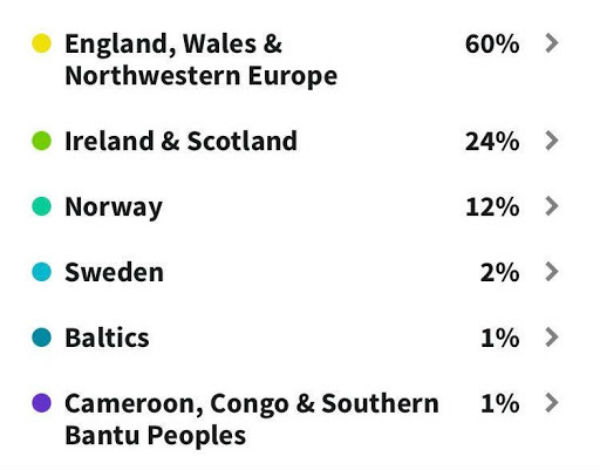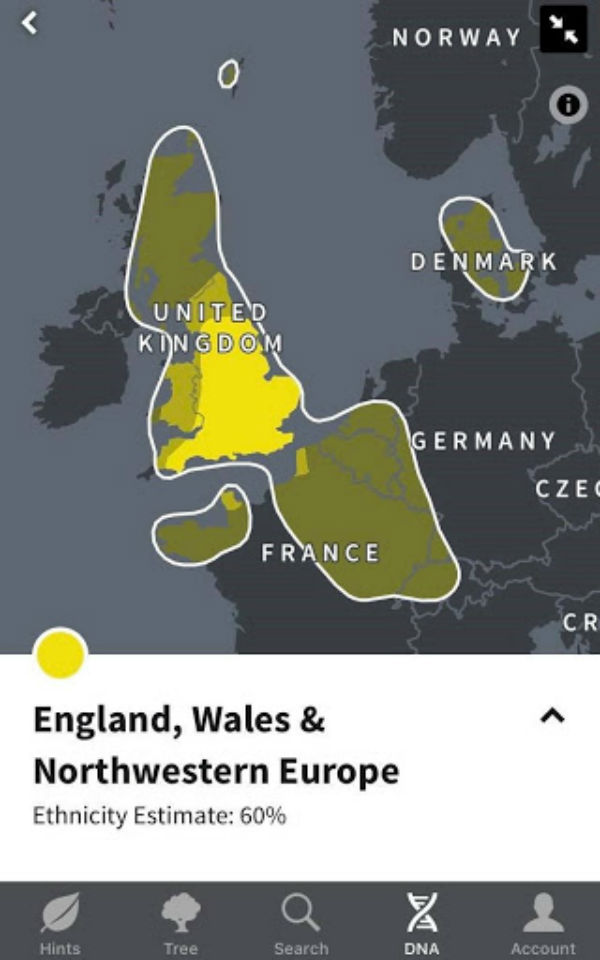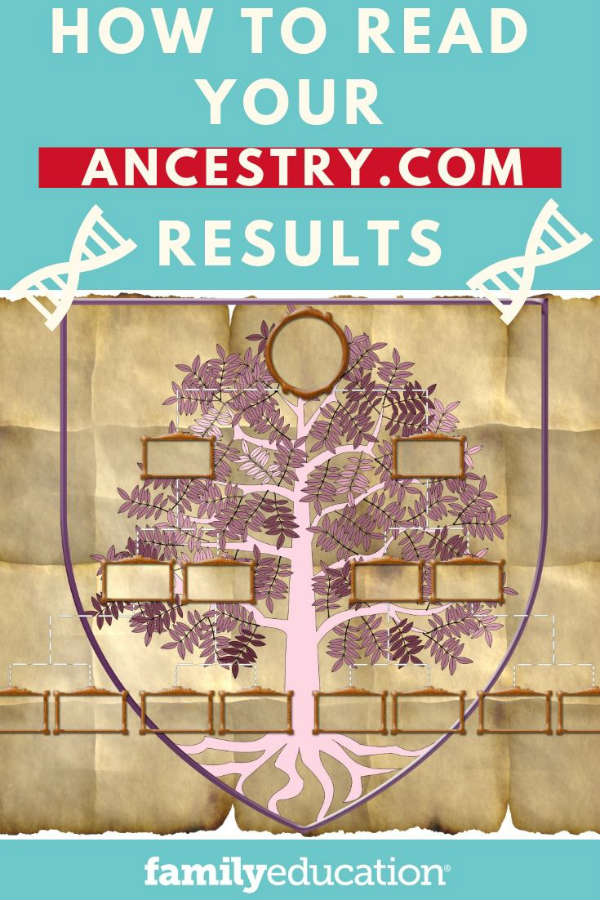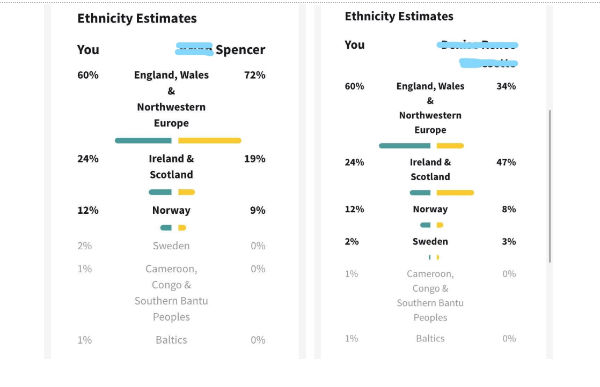How to Read Your Ancestry.com Results

So you’ve sent off your magical vial of saliva and the moment you’ve been waiting for has finally arrived… your AncestryDNA results! You start to sweat a few bullets when you ask yourself for the hundredth time, “What cultures run through my blood?” “Will I have to trade in my Kiss Me I’m Irish t-shirt for a Lederhosen?” “Are my long-lost cousins going to be on here, too?”
So many questions! You open your results and all you see are varying numbers and percents, countries encircled in different shades, and words that make your eyes go crossed… so now what?
More: How to Choose a Baby Name Inspired by Your Family Tree
With the help of Ancestry.com gurus and my own family’s genealogy buff, Ryan Spencer, this article gives you more insight into how you can read your AncestryDNA results with more clarity.
How does the AncestryDNA test work?
Your Inherited DNA
AncestryDNA is used to help find people you are related to while also revealing your unique ethnic origins. Knowing a little about the science behind how your DNA is inherited will help you understand how your ethnicity results are calculated and how your DNA matches are found.
The most important aspects to know about genetics are:
- You receive 50% of your mother’s genes and 50% of your father’s.
- Your father received 50% of his father’s genes and 50% of his mother’s. The same is true for your mother but from her own parents.
- Your paternal and maternal grandparents received 50% from each of their parents…
- And so on, and so on, and so on.
Notice a pattern?
Because of the continuous halving of DNA throughout the family tree, you can probably imagine how diluted your genes are from your great-great-great-great-great grandparents on either side! This means that over time, things can get a little lost in the mix, so to speak, especially because all of that halving is totally random.
As Crista Cowan, the Barefoot Genealogist from Ancestry.com says in her video, “Some things won’t be inherited from parents to children, even though your parent inherited something from his dad.” The same is true for your siblings, as they will also inherit 50% of each of your parent's genes, but just not the same as yours unless you're identical twins.
AncestryDNA’s Reference Panel
After receiving your DNA sample, scientists with AncestryDNA analyse your autosomal DNA, which is a test that looks at your entire family tree instead of just your father’s and mother’s lines. But it’s not just one test, it’s actually forty tests. In each of these forty tests, 700,000 of your DNA markers are compared to AncestryDNA’s meticulously chosen reference panel of individuals from over 150 regions around the world.
The members of the reference panel are people whose families have lived in that one region for generations and have deeply embedded roots in the area. The scientists will use the identified trends of the region to search for similarities in your test results. These calculations will appear in the first, and often most anticipated section of the DNA results: Ethnicity Estimates.
Interpreting Your Ethnicity Estimates
One of the key results you’ll obtain is an estimate of your ethnicity. This is shown with pie charts, percentages, and maps of regions where you’re most closely related. The colored pie chart is divided into wedges that are equivalent to the percentages that are shown. These numbers represent the origins of your ancestors.
The Percentage Chart

The percentage is the average of those forty tests for each region and is an estimate. As an example, my brother’s results shown in this first image reveals his very strong ties to northern Europe. The 60% is the average range of comparisons from AncestryDNA’s reference panel in that region.
The next level in the image shows a 24% average match to Ireland and Scotland. When he clicks on the little arrow, he will be able to see the range in a line graph and how it looks on the map.
The low-confidence area makes up the smallest averages. There is a big possibility that you may not have any genetic ethnicity from them at all, but some experts claim you shouldn’t disregard them as they may provide hints into a much deeper past.
The Ethnicity Map

The maps work in conjunction with your estimates. Not only do they provide a visual representation of potential areas, but they also shed light on why you may have never heard of any family members ever living in, say, Norway.
A region, by AncestryDNA’s terms, is not bound by political borders or countries. It includes several regions that are labeled as countries, but to our DNA they can extend beyond those borders.
The maps show circles that recede in coloration the further it gets from your focused region. For example, if you are looking at Great Britain as one of your regions, you can expect it to be, “Primarily DNA found in England, Scotland, Wales, but also found in Ireland, France, Germany, Denmark, etc.” says Cowan.
Using my brother’s England, Wales and Northwestern Europe image below from the AncestryDNA app, you’ll notice the smallest but brightest yellow circle covers most of England. The darker the shading, the more likely your ancestors lived there. But by the time you get to the outermost ring, you’ll notice that DNA from this region can also be found throughout most of Great Britain.
The outer ring encompasses a much larger area, which is likely due to all of the migrations that took place over the past several centuries: Romans, Norsemen, and Germanic tribes for example. You can read about the invasions and migrations underneath the map when you click on the Region History tab.
Here are the steps consolidated from AncestryDNA’s support page to explore your Ethnicity Estimate:
Step 1: From anywhere in your Ancestry account, click the DNA tab and select DNA Story from the drop-down menu.
Step 2: From the Ethnicity Estimate panel, select any region you want to look at.
Step 3: Once selected, the region will be highlighted on the map, showing you the possible range for that ethnicity. You’ll also see Communities, which explains your connection to this region.
Step 4: Click on an area of the world from the list of all regions to see its details. The next page will show regions with colored or gray dots beside them. Colored dots appear in your ethnicity results; gray dots do not.
Step 5: Click on the questions marks for links to more information such as how your ethnicity estimate was determined, who “typical natives” are, and more information about trace regions. If you like reading about the science behind it all, don’t pass up the Whitepaper written by AncestryDNA’s scientists and genealogists.
Extras: Click on See other regions tested to display all of the regions tested that didn’t appear in your results. Click on Additional Communities to see other AncestryDNA members who may have a connection with you. More of this will be discussed in the next section, DNA Matches.
Pin it to save for later:

DNA Matches and Your Public Tree
Finding Matches
The other major advantage of doing a DNA test is the possibility of finding relatives from potentially all over the world. If you’ve chosen to be listed as an AncestryDNA match, you’ll be able to see people you may be related to.
In short, AncestryDNA compares your results to the results of every sample in their database. They’re looking for segments of DNA (not data from your family tree) that you have in common with millions of other test results cataloged on AncestryDNA.
When they find a match that’s reputable enough to indicate a possible relationship, they will calculate the closeness of the relationship based on how much you share from a common ancestor. Your matches are visible when you click on the See Matches button or the View All DNA Matches button on your home page.
You can also click on Additional Communities on your Ethnicity Estimate panel to explore groups of AncestryDNA members who may have descended from a population of common ancestors.
Linking to a Public Family Tree
The more family members that get tested and link their results, the easier it is to verify relationships in your matches and to build your family tree. “Getting my AncestryDNA opened up more questions. I wanted more detail, so I started working on a tree. While I have a long way to go on this tree, the results, as far as where many of my ancestors came from, match up pretty well to my DNA,” says Spencer.
- The first step is to link your AncestryDNA results to a public family tree. You can do this from your DNA homepage. If your match(es) have also linked their results to their online family tree, then AncestryDNA can compare and determine in categories how you are related. You can see an explanation of the DNA Match Categories here.
- You can also contact your matches to share information and ask questions. Click on Message, after clicking on the match in your list of matches.
- To compare your DNA results to your matches’ results, click on the match you’re interested in. The lowercase “i” inside of the Predicted Relationships section will tell you many centimorgans are shared across a number of DNA segments. Click on What does this mean? in the same box and it will tell you what level you share with that person. Click on the Ethnicity tab from their profile page to see your shared ethnicity.
- If you are receiving a lot of DNA matches and it’s become overwhelming, you can use filters to help narrow it down.
Major Takeaways for Using Ancestory.com
You’ll need to remember that the Ethnicity Estimate is not a comprehensive view of the identity of all of your ancestors. It’s only what you inherited from them. If both of your parents take the test, you’ll be able to see what ethnicity percentage you obtained from them. You can see this from my brother’s results from both of our parents:

Also, getting a DNA test can give insight into your ancestry while also revealing some unintended surprises. “Be prepared for that,” Cowan advises. “Just because all four grandparents came from Ireland, doesn’t mean they were Irish.”
This was especially true for my siblings’ tests. Although we do have roots in Ireland, we also found Scandinavian DNA, which we learned were more likely the result of Viking raids and settlements. Even though this makes more sense as to how my physical features are more closely related to Scandinavian than Irish, we can still claim our Irish heritage.
Europe is one of those tough regions to find patterns that are distinct enough to tell one group from another because so many people have come and gone. That’s why AncestryDNA continues to collect samples while improving their reference panel.
“The funny thing,” says Spencer, “is this is like a newer mainstream science, so of course, they are still working out all of the kinks. But it gets better every year - the estimates tighten and narrow down to more concentrated areas of the world. My mother’s recent update pinpointed not only a country but a county (Cork, Ireland) where some of her family came from. This is great because it’s confirmation of what we know from verbal family history.”
The more we look into our AncestryDNA results, the more we realize how much more we will learn if other members of our family take the test. “As an American, you know you come from a melting pot. You often wonder where your ancestors came from. How and why did I get here?” says Spencer. “Getting my DNA analyzed both, as well as answered and begged more questions.”
Learning about your AncestryDNA results is a hobby that no doubt turns into a passion, especially if you know how to do it correctly.
Considering researching your family history and genealogy? Here are the 5 Questions to Ask Yourself Before Starting a Genealogy Search.

